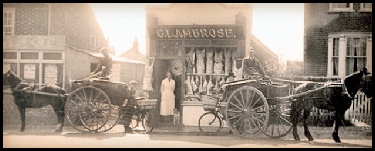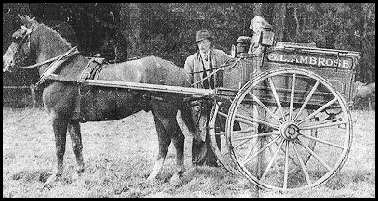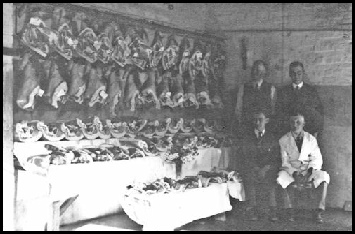
WESTBOURNE
A village history in West Sussex
Home | Personal | Church | Scouts | Schools | Ambrose | Sketchbook | Workhouse | Census | Memories | Yesteryear | Publications | Village Website
 During my teens in addition to being a paper boy for Cripps the newsagent I started as an errand boy for Ambrose the butcher. It was just a few yards across the road so no great journey. Tasks ranged from helping in the shop to making deliveries on a bicycle with a large basket on the front. One route was down through the village, along Southleigh Road, up Hollybank Road and back to the shop. Shorter journeys were up to the top of Monks Hill to Miss Bennett and Miss Fogwell. Their corned beef meat ration was just enough for a sandwich. My worst days for deliveries were twofold. Firstly, when stopped by the Weights & Measure officers. They would check the weight for each customer with the delivery ticket. Unfortunately they did not put the items back in the same order for delivery. Secondly when it was raining hard requiring a change of clothes on returning to the shop. There was also a Friday evening delivery with either Mr or Mrs Ambrose in the van. This took us out via Aldsworth to Churches Corner farm , Funtington and then onto East Ashling towards Chichester. My 'posh' delivery was to the tradesman door on the Sennicotts estate to a Bowes-
During my teens in addition to being a paper boy for Cripps the newsagent I started as an errand boy for Ambrose the butcher. It was just a few yards across the road so no great journey. Tasks ranged from helping in the shop to making deliveries on a bicycle with a large basket on the front. One route was down through the village, along Southleigh Road, up Hollybank Road and back to the shop. Shorter journeys were up to the top of Monks Hill to Miss Bennett and Miss Fogwell. Their corned beef meat ration was just enough for a sandwich. My worst days for deliveries were twofold. Firstly, when stopped by the Weights & Measure officers. They would check the weight for each customer with the delivery ticket. Unfortunately they did not put the items back in the same order for delivery. Secondly when it was raining hard requiring a change of clothes on returning to the shop. There was also a Friday evening delivery with either Mr or Mrs Ambrose in the van. This took us out via Aldsworth to Churches Corner farm , Funtington and then onto East Ashling towards Chichester. My 'posh' delivery was to the tradesman door on the Sennicotts estate to a Bowes-
It was always a hectic business particularly for me in holiday time as a teenager in the school holidays. While Mr or Mrs Ambrose was busy in the shop serving customers Harrry Goble and I were working out the back preparing joints, skinning rabbits and gutting chickens. Mondays were set aside for cutting up over a 100 pounds of meat for beef or a side of pork for sausages. This was then mixed with salt, pepper, herbs and bread crumbs and minced together. The next stage was to feed this mixture in a hand machine to produce yards of sausage skeins. These were then doubled back, twisted into pairs at about 8 sausages a pound. This task could take all morning and if demand was such another batch would be made later in the week. The quality of these sausages was such that people would travel miles to buy them. In fact his premier pork sausages went as far apart as Devon and Scotland in my later married life.
 There was also deliveries across country by horse and cart made by Harry. The photo shows Sandy the horse, Harry Goble and in the driving seat Madeline Ambrose. One delivery round went up to one of the cottages on the Stansted Estate, across farm tracks to homes in West Marden and returning via Walderton. When on holiday I used to accompany him and on a few occasions was allowed to make deliveries on my own. Another disaster occurred when making a delivery to Woodmancote similar to one experienced by Harry elsewhere. I was going up the hill from the old slaughterhouse when the back trap door opened and deposited my delivery on the road. Fortunately the tray remained intact keeping the orders from spilling out. The fun part for me was after returning to the stables and taking off the harness. This was riding Sandy bare back to the fields that were off the road to Aldsworth. Catching him again for another delivery could be tricky. He could dash off as far a he could go or eventually be tempted to take a meal of oats out of a bucket for a halter to be secured. Then another bare-
There was also deliveries across country by horse and cart made by Harry. The photo shows Sandy the horse, Harry Goble and in the driving seat Madeline Ambrose. One delivery round went up to one of the cottages on the Stansted Estate, across farm tracks to homes in West Marden and returning via Walderton. When on holiday I used to accompany him and on a few occasions was allowed to make deliveries on my own. Another disaster occurred when making a delivery to Woodmancote similar to one experienced by Harry elsewhere. I was going up the hill from the old slaughterhouse when the back trap door opened and deposited my delivery on the road. Fortunately the tray remained intact keeping the orders from spilling out. The fun part for me was after returning to the stables and taking off the harness. This was riding Sandy bare back to the fields that were off the road to Aldsworth. Catching him again for another delivery could be tricky. He could dash off as far a he could go or eventually be tempted to take a meal of oats out of a bucket for a halter to be secured. Then another bare-
 The shop was only part of the Ambrose business, another was the slaughterhouse at the bottom of his garden together with stables, tack room and pig sties. He also had a couple of ferrets who enjoyed the occasional chicken head. During the war and after when meat was rationed extras were obtained by a group of villagers who formed a pig club. With the support of Mr Ambrose the pigs were housed in sties that backed onto Ellesmere Orchard into which the manure and straw was dumped to mature. Over several months the club members collected swill comprising household scraps from friends and neighbours. Each day the swill was mixed with water and cooked in a large steel pot heated by a log fire. The timing was that the pigs were fattened for Christmas when they were slaughtered. The picture shows the joints of pork proudly displayed by Mr Ambrose, Mr Todd and other helpers. How the joints were allocated to club members cannot be recalled. What is remembered is that our regular favorite joint was a hind leg, and very good it was too. We were told the only bit of the pig you couldn't eat was the squeak!
The shop was only part of the Ambrose business, another was the slaughterhouse at the bottom of his garden together with stables, tack room and pig sties. He also had a couple of ferrets who enjoyed the occasional chicken head. During the war and after when meat was rationed extras were obtained by a group of villagers who formed a pig club. With the support of Mr Ambrose the pigs were housed in sties that backed onto Ellesmere Orchard into which the manure and straw was dumped to mature. Over several months the club members collected swill comprising household scraps from friends and neighbours. Each day the swill was mixed with water and cooked in a large steel pot heated by a log fire. The timing was that the pigs were fattened for Christmas when they were slaughtered. The picture shows the joints of pork proudly displayed by Mr Ambrose, Mr Todd and other helpers. How the joints were allocated to club members cannot be recalled. What is remembered is that our regular favorite joint was a hind leg, and very good it was too. We were told the only bit of the pig you couldn't eat was the squeak!
A few years later when I became his errand boy my experience in the slaughterhouse began. The team, if that is the right word, was Mr Ambrose the registered slaughterman, a helper whose name cannot be recalled, Harry Goble and me. Most of the animals slaughtered were pigs, although there was the occasional goat from a private owner. The morning of the day for slaughter was started filling the large coppers with water that was heated to boiling point. In the centre of the slaughter room, shown above, was a very large domestic bath that was filled with the boiling water. After a pig was killed its throat was cut and hung up to drain out all the blood. It was then lifted into the bath and the hot water softened the skin to allow the hair to be easily removed together with its toenails. It was then hung up again and cut from throat to tail. It was my task to collect the innards in my arms and transfer them to a bench for cleaning. The tongue, lungs, heart and liver, called the pluck, was then removed all connected and hung on a hook. My next task was to clean the contents from the small intestine, called chitterlings, for making into a meal for the dinner table. Meanwhile the pig carcase was hung on a rail and would stay there for inspection and then for jointing in the shop. Some of the hind legs were salted for a few weeks in a bath and then smoked in a kiln next to the shop.
Before Christmas Mr Ambrose would visit the livestock shows and buy one of the prize cows as a special treat for his customers. The dressed carcass together with turkeys, geese and chickens were a major display in his shop and attracted much admiration and visitors from afar. Christmas was a busy time for me and Harry, who killed the birds, and we spent hours plucking them.
Towards the end of my employment Mr Ambrose started to branch out from pigs to cattle. The first batch of about 15 cows arrived at Emsworth Railway station. They were then walked from there to Westbourne by road. My task was go ahead, warn traffic and ensure that gates were closed and guide the cattle past side roads and other openings. A task that we all achieved successfully. For whatever reason, I found the killing of cattle unsettling. Perhaps it was because he had his own few cows that were used for milk and butter. I would collect them from the fields where Sandy the horse grazed and return them later. They had names and it can be understood how farmers get attached their animals and are sad to see them eventually move on.
